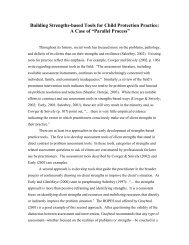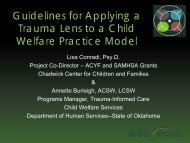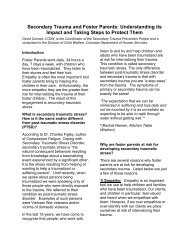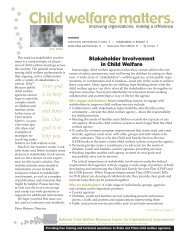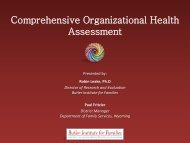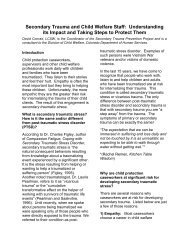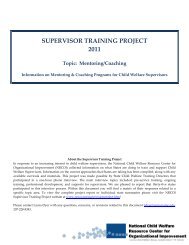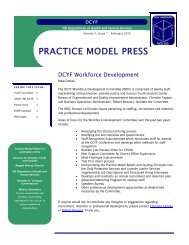Building a Model and Framework for Child Welfare Supervision
Building a Model and Framework for Child Welfare Supervision
Building a Model and Framework for Child Welfare Supervision
You also want an ePaper? Increase the reach of your titles
YUMPU automatically turns print PDFs into web optimized ePapers that Google loves.
Manage caseloads in the supervisor’s unit. To assure timely <strong>and</strong> appropriate services, supervisors<br />
manage case assignment <strong>and</strong> monitor services within their units. Assignment of cases takes into<br />
account policy regarding reasonable <strong>and</strong> equitable caseload size, staff members’ experience <strong>and</strong><br />
abilities, <strong>and</strong> factors such as case type <strong>and</strong> complexity.<br />
Manage time <strong>and</strong> workflow <strong>for</strong> supervisor. Supervisors must not only know time management<br />
principles, but also persevere in applying them, including determining what investments of time will<br />
result in time saved <strong>and</strong> setting aside time <strong>for</strong> activities that require concentration.<br />
Monitor frontline practitioners’ responsibilities to <strong>Supervision</strong> is a two-way street. You<br />
supervisor. For supervision to be effective, supervisors need to connect with the worker, learn<br />
rely on their supervisees to share in<strong>for</strong>mation about their<br />
cases with them in a timely way, engage in ongoing selfassessment<br />
concerning their training needs <strong>and</strong> the them develop strategies. To get caught<br />
in<strong>for</strong>mation about the families, <strong>and</strong> help<br />
sources <strong>and</strong> extent of their stress, <strong>and</strong> develop an agenda not knowing something about a case is<br />
<strong>for</strong> regularly scheduled supervision. Supervisees should<br />
bad. – Supervisor<br />
participate in planning the agenda <strong>for</strong> supervision. By<br />
identifying their needs <strong>for</strong> learning, emotional support,<br />
<strong>and</strong> assistance with administrative issues, supervisees actively engage in reflection <strong>and</strong> critical thinking<br />
about their practice <strong>and</strong> share ownership <strong>for</strong> their professional development <strong>and</strong> job per<strong>for</strong>mance.<br />
Provide leadership to their unit. <strong>Child</strong> welfare practitioners are typically assigned to a unit that is<br />
supervised by one supervisor. Supervisors provide leadership to their unit by focusing on shared<br />
commitment to the organizations’ service<br />
mission <strong>and</strong> to high quality services;<br />
defining best practice; serving as a role<br />
model with regard to professional ethics <strong>and</strong><br />
st<strong>and</strong>ards, collaboration, <strong>and</strong> open<br />
communication; <strong>and</strong> promoting a positive<br />
<strong>and</strong> mutually respectful work culture.<br />
Promoting a positive work culture includes<br />
The supervisor sets the tone <strong>and</strong> the st<strong>and</strong>ards <strong>for</strong><br />
caseworkers. When the unit has a strong leader,<br />
the workers in the unit per<strong>for</strong>m better. –<br />
Supervisor<br />
supervisory behaviors such as acknowledging practitioners’ ef<strong>for</strong>ts, effective per<strong>for</strong>mance, <strong>and</strong><br />
accomplishments; modeling high practice st<strong>and</strong>ards; being sensitive to staff needs <strong>and</strong> feelings;<br />
supporting a climate of trust <strong>and</strong> openness; <strong>and</strong> using mistakes as an opportunity to teach <strong>and</strong> learn<br />
(CO DHS 1994).<br />
Provide leadership within the organization. Within the organization,<br />
supervisors are often asked to lend their knowledge <strong>and</strong> expertise to task<br />
groups as well as to initiatives regarding staff recruitment <strong>and</strong> service<br />
coordination, improvement, <strong>and</strong>/or development. Developing <strong>and</strong> maintaining<br />
positive ongoing relationships within the agency facilitates opportunities <strong>for</strong><br />
supervisors to provide leadership through such ef<strong>for</strong>ts.<br />
Anticipate, address, <strong>and</strong> manage change within the unit. Change is a<br />
constant in child welfare policy <strong>and</strong> practice. There<strong>for</strong>e, supervisors must<br />
anticipate new circumstances within their units; involve them in generating<br />
ideas <strong>and</strong> plans <strong>for</strong> implementation of change; encourage receptiveness to<br />
change; <strong>and</strong> monitor <strong>and</strong> address its effects.<br />
Organizational<br />
climate is the best<br />
protective<br />
factor—there is a<br />
real sense that<br />
“we’re in this<br />
together.” –<br />
Administrator<br />
14




